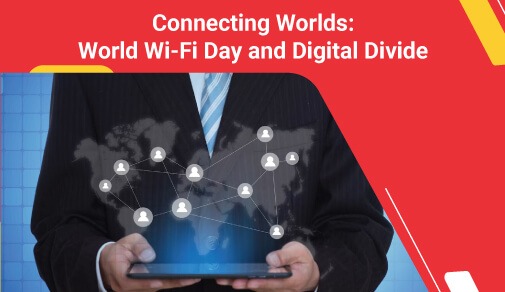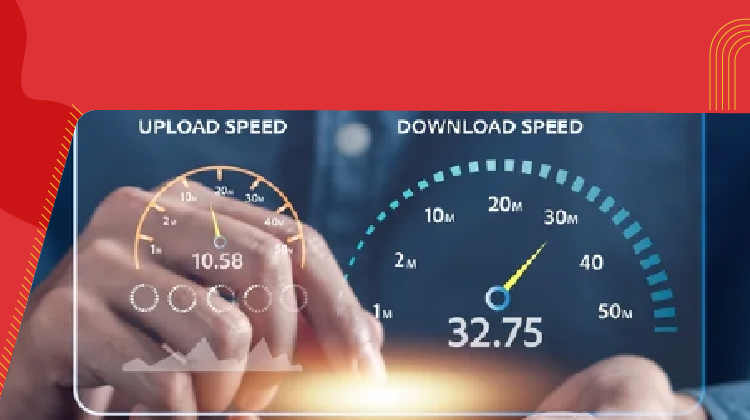World WiFi Day
Friday, Jul 07, 2023 · 7 minutes


WORLD WIFI DAY
Friday, Jul 07, 2023 · 7 minutes
In today's rapidly advancing world, access to the internet has become an essential part of our daily lives. It has transformed how we communicate, learn, work, and access vital services. However, while many people enjoy the benefits of seamless connectivity, a significant divide separates those with access to digital technologies from those without. This gap, known as the digital divide, has profound implications for individuals, communities, and nations.
The digital divide contains various dimensions, including geographical, socioeconomic, and gender disparities. In a world where connectivity drives progress and opportunity, those left on the wrong side of this divide face significant challenges in accessing information, education, healthcare, employment, etc.
Realising the issue, governments, organisations, and individuals worldwide have rallied together to bridge this divide and create a more inclusive digital society. Promising strides have been made to ensure equitable access to the digital world through concerted efforts, innovative initiatives, and the power of technology.
As of 2023, the current global count of smartphone users stands at a staggering 6.92 billion, signifying that approximately 86.11% of the world's population possesses a smartphone, showcasing the widespread adoption and significance of this technology.
Without a smartphone and the Internet, individuals may struggle to access essential services, stay updated with news and information, connect with others socially, and find job opportunities.
Moreover, as more services like applying for unemployment benefits or scheduling medical appointments move online, the impact of the digital divide becomes even more significant.
In India, many people face problems with internet connectivity. During the lockdown, around 80% of Indian students could not access online classes, and many could not continue their studies when schools reopened. This is an example of how the pandemic has widened the digital divide in the country.
It has worsened the existing inequality and hindered economic growth. While this divide is not unique to India, it is particularly significant in a country where more than half the population is under 25.
For example, imagine a student in a remote village who doesn't have access to the internet. They may struggle to keep up with their studies because they can't attend online classes or access educational resources available online. This puts them at a disadvantage compared to students with internet access who can easily continue their education online.
The two variables that contribute most to the digital divide are:
Closing the gap between rural and urban areas in terms of internet access is a challenging task. Expanding broadband services to rural regions requires a lot of money and time. The government has invested billions of dollars in the past five years to improve internet connectivity in rural areas. However, despite these efforts, the issue of broadband access persists.
Even though many people in India live in urban areas with multiple internet providers, millions still don't have an internet connection. The Pew Research Center found that over half of these individuals believe internet services are too costly. In simple terms, they cannot afford to pay for an internet connection.
The standard for high-speed internet is 25 megabits per second (Mbps) for downloads and three megabits per second for uploads. However, it is believed that over 90% of Indians who have internet access enjoy download speeds of at least 100 Mbps. When it comes to expanding broadband to rural areas and low-income families, there will still be a significant difference in internet speeds. The gap between 25 Mbps, 100 Mbps, and 250 Mbps is quite large.
For example, If a family has only 25 Mbps internet speed, it would be challenging for everyone to work or learn remotely because the speed might be too slow. On the other hand, if the family has 100 Mbps, it would be sufficient for two to three family members. If the speed is even higher, like 250 Mbps, it would be enough for five to six family members.
Nielsen's India Internet Report 2023 revealed that India boasted an astonishing number of over 700 million active internet users. Surprisingly, rural India constituted a significant majority, with 425 million users, surpassing urban areas by nearly 44%, where 295 million users were recorded.
It worsens socioeconomic inequalities, with certain groups facing more challenges than others. Moreover, rural areas are often more disadvantaged in internet access than urban regions.
India's digital divide encompasses multiple facets, including the knowledge and skills divide, the digital gender divide, etc. Some aspects of India's digital divide are:
This facet relates to the gap in digital literacy and skills needed to utilize digital technologies effectively. Lack of knowledge and skills can hinder individuals from maximizing the benefits of the internet and engaging in online activities such as accessing information, online learning, and digital transactions.
The content facet refers to the discrepancy in relevant and localized digital content availability. Limited availability of content in local languages and lack of diverse and inclusive digital resources can limit the usefulness and accessibility of the internet for specific segments of the population.
This facet relates to the differences in the extent and purpose of internet usage among individuals and communities. Variations in the types of online activities, such as education, e-commerce, and e-governance, can impact the digital experience and opportunities available to different groups.
According to GSMA's Gender Gap Report 2023, there exists a notable gender disparity in mobile internet usage, with women being 19% less likely than men to utilise it. Out of the 900 million women who remain disconnected, a significant majority—almost two-thirds—reside in South Asia and Sub-Saharan Africa, regions characterised by the widest mobile gender gaps.
Both financial constraints and cultural and social norms influence this disparity in technology access between men and women. For example, some women may face restrictions or lack opportunities to own a cell phone or laptop due to societal expectations or limitations. This gender divide in mobile usage further amplifies existing inequalities for women, affecting their access to information, economic opportunities, and networking prospects.
India's digital divide is large, with 700+ million people without internet access. Disparities exist between rural and urban areas and between men and women in smartphone access. The government is working to bridge the divide by improving connectivity and promoting digital skills.
The goal is to reduce the gaps in internet access and technology usage, thus enabling more equitable opportunities for all Indians. The efforts of the government are mentioned below:
1.The BharatNet project started in 2011, aims to connect rural villages and approximately 250,000 panchayats (local administrative bodies) through a high-speed optical fibre network.
2.The National Digital Literacy Mission and Digital Saksharta Abhiyan were launched in 2014 to enhance digital literacy skills among the population.
3.The Digital India campaign, initiated in 2015, introduced various programs to connect promoters' countries and promote digital inclusion.
4.The PM Gramin Digital Saksharta Abhiyan, launched in 2017, focuses on providing digital literacy training to around 60 million rural Indian families.
ACT Fibernet, a leading internet service provider, has taken various initiatives to positively impact and bridge the gap in different communities. The major initiatives include:
1.In Bangalore, they set up eight wifi hotspots and 2 TVs connected to a streaming device in a migrant labourer camp, providing communication and entertainment for 1000 people. This allows labourers to browse the internet with a speed of 20 Mbps and unlimited data.
2.In Chennai, ACT Fibernet created wifi hotspots at Nageshwara Park to contribute to the development of smart cities. This helps people in the park to access the internet and enjoy the benefits of connectivity.
3.ACT Fibernet established a knowledge centre in the City Armed Reserve (CAR) Headquarters on Mysore Road, Chamarajpet. This centre provides computers, a library, and educational materials for the children of the City Armed Reserve.
These initiatives by ACT Fibernet demonstrate their commitment to bridging the digital divide, empowering communities, and providing equal opportunities for people to access information, education, and entertainment through digital technologies.
ACT Fibernet, as renowned provider of high-speed and affordable internet connectivity, is gearing up to celebrate World WiFi Day on June 20th, 2023. Recognizing the immense significance of WiFi in today's digital world, ACT Fibernet is committed to delivering seamless connectivity to its users.
On this special occasion, the company has planned a range of exciting initiatives to promote awareness and appreciation for WiFi technology. Through innovative services and customer-centric approach, ACT Fibernet aims to empower individuals and communities with reliable and fast internet access, fostering a more connected and digitally empowered society. Visit our website to know more!
101

The New Social: How High-Speed Internet is Redefining 'Quality Time' with Friends and Family
Read more392

How ACT SmartWi-Fi is Redefining Home Internet in 2025: The Age of AI-Powered Seamless Connectivity
Read more152

From Bandwidth to Intelligence: How AI Is Redefining Business Demands from ISPs
Read more
A referral link has been sent to your friend.
Once your friend completes their installation, you'll receive a notification about a 25% discount on your next bill
![]() Please wait while we redirect you
Please wait while we redirect you

![]() One of our representatives will reach out to you shortly
One of our representatives will reach out to you shortly

One of our representatives will reach out to your shortly
![]() Please wait while we redirect you
Please wait while we redirect you

Please enter your registered phone number to proceed

Please enter correct OTP to proceed


Dear customer you are successfully subscribed
Please wait while we redirect you

Your ACT Shield subscription has been successfully deactivated

Dear user, Your account doesn't have an active subscription

Dear customer Entertainment pack is already activated.
Please wait while we redirect you